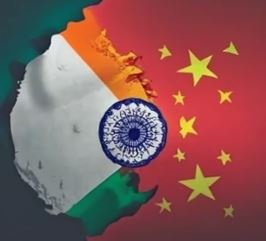Microcosm of New Strategic Contest in IOR: 1 Indian Navy & 3 Chinese Warships Dock at Colombo Port
Microcosm of strategic contest is at display at Colombo Sea-Port, Sri Lanka. Indian Navy’s INS Mumbai and 3 Chinese Warships docked at Colombo port in Sri Lanka simultaneously. This is more than a mere coincidence; it is a significant show of the ongoing strategic competition between two of Asia’s ultimate powers and thick geopolitical dynamics at play in the Indian Ocean Region (IOR).
Indian Navy and Chinese Navy are contesting for influence and control in the Indian Ocean. Here’s an in-depth article at why this incident is profound linked to regional security and diplomacy.

Indian Navy’s INS Mumbai is a 163-Meter-Long destroyer, which accommodates more than 400 sailors, arrived at the port of Colombo, on 26th Aug 2024. As per reports, the destroyer is scheduled to participate in PASSEX (Passage Exercise) with Sri Lankan Navy off Colombo Coast, which is a pre-planned navy drill.
At the same time, 3 Chinese Warships (He Fei, Wuzhishan, Qilianshan) have reached Colombo port on 26th Aug 2024 on a formal visit & to participate in a PASSEX with Sri Lankan Navy. He Fei is a 144.5-meter-long destroyer boarded by almost 250 crew members. Wuzhishan & Qilianshan are landing platform docks, having nearly 1200 sailors on them.
Although, the visits by both Indian Navy & Chinese Navy warships are part of pre-planned drills, but the concurrent docking of destroyers of rival navies, is a testimony of the contest in Indian Ocean to project Power, enforce influence.

Symbolic Power Play
The docking of the Indian Navy’s INS Mumbai and three Chinese Navy vessels at Colombo port is a show of force of both nations’ intent to project power and influence in the Indian Ocean Region. This region is pivotal for global trade and energy resources, and both India and China trust heavily on these sea paths for their energy imports. Strategic analysts do not just see this as just a logistical coincidence but a tactical decision to flaunt their naval range and proclaim dominance.

Diplomatic Balancing Act by Sri Lanka
Sri Lanka’s decision to host both Indian and Chinese warships simultaneously proves its subtle balancing act in maintaining good relations with both India & China. This is in Sri Lanka’s own interest, which depends on both India and China for financial & defense support. Sri Lanka is indicating its resolve to stand neutral and gain benefit from the competition.

Strategic Messaging
For India, docking the INS Mumbai at Colombo is a reaffirmation of its “Neighborhood First” policy, emphasizing its commitment to its central tenet of foreign policy i.e. strengthening ties with neighboring countries. This move is a clear message to China and other regional players that India is serious about its strategic interests in the IOR (Indian Ocean Region) and Indian Navy will play a profound strategic role in the Indian Ocean Region.
For China, the presence of its naval ships signals its efforts in growing naval capabilities and its strategic interests in the region. This is part of China’s broader strategy under the Belt and Road Initiative (BRI), which includes significant investments in port infrastructure across the IOR.
Regional Security Dynamics
The event highlights the increasing militarization of the Indian Ocean, with both Indian Navy and China enhancing their naval presence. This has implications for regional security, as it could lead to an arms race and increased tensions. The Indian Ocean is home to several strategic chokepoints, such as the Strait of Malacca, through which a significant portion of global trade passes, especially China’s 80% of Oil import passes through Strait of Malacca, which Indian Navy can block during any strategically critical conflicts.
Control over these chokepoints is vital for both India and China, making the region a focal point of their strategic interests. The event carries utmost importance amid an ongoing border dispute in Ladakh, where both Indian and Chinese army are invoved in an almost 3 yearlong stand off, that has seen nearly 20 Indian soldiers losing their lives and undisclosed number of soldiers died in Chinese side.

Economic Interests
Both India and China have significant economic interests in Sri Lanka, including investments in port infrastructure. China’s development of the Hambantota Port under the BRI is a prime example of its strategic investments in the region. India, on the other hand, has been developing ports in countries like Iran (Chabahar Port) and Seychelles to counter China’s influence. The docking of warships by Indian Navy & Chinese Navy can be seen to protect and promote these economic interests, ensuring the security of their investments and trade routes.
Public Perception
Such events also shape public perception and influence the narrative around the strategic competition between Indian Navy and Chinese Navy. The simultaneous docking of warships sends a message to other countries in the region about the naval capabilities and strategic intentions of both nations. It highlights the importance of the IOR in global geopolitics and underscores the need for regional players to navigate this complex landscape carefully.
The simultaneous docking of Indian and Chinese warships at Colombo port is a microcosm of the wider strategic contest between India and China in the Indian Ocean Region. It pinpoints the geopolitical importance of the region, the diplomatic balancing act of smaller nations like Sri Lanka, and the strategic messaging of both major powers in Asia at a time there is an ongoing standoff between armies of both countries in Ladakh.
As India and China continue to enhance their naval presence and invest in port infrastructure, the IOR will remain a critical theater for their rivalry. This incident serves as a reminder of the delicate dynamics of power and influence that defines the Indian Ocean Politics.

4 thoughts on “Microcosm of New Strategic Contest in IOR: 1 Indian Navy & 3 Chinese Warships Dock at Colombo Port”